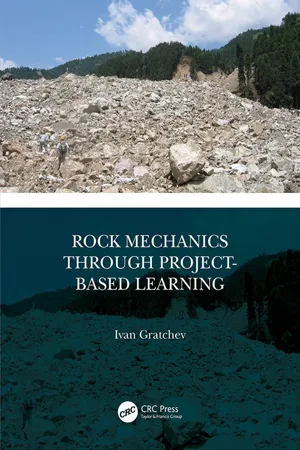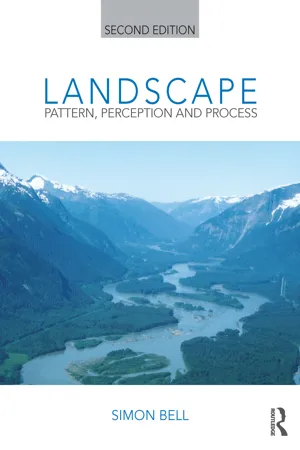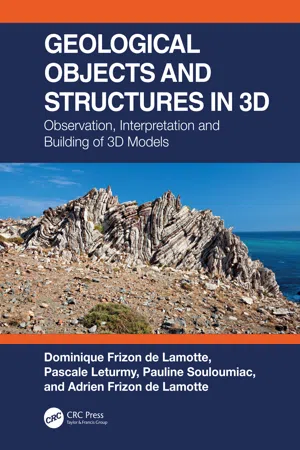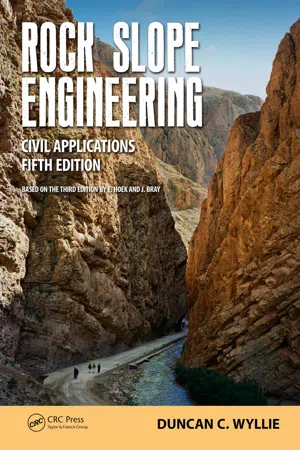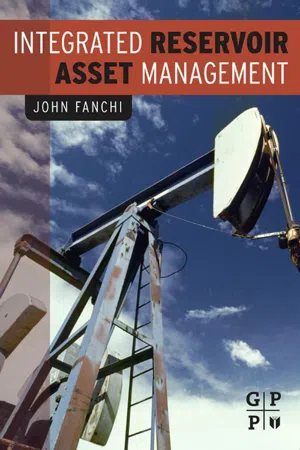Geography
Geological Structure
Geological structure refers to the arrangement and orientation of rock layers, faults, and folds within the Earth's crust. It encompasses features such as anticlines, synclines, and fault lines, which influence the landscape and natural resources. Understanding geological structure is crucial for geologists and geographers in interpreting the formation and evolution of landforms, as well as in resource exploration and environmental management.
Written by Perlego with AI-assistance
7 Key excerpts on "Geological Structure"
Learn about this page
Index pages curate the most relevant extracts from our library of academic textbooks. They’ve been created using an in-house natural language model (NLM), each adding context and meaning to key research topics.
- eBook - ePub
- Ivan Gratchev(Author)
- 2019(Publication Date)
- CRC Press(Publisher)
Chapter 3Rock mass formation
Project relevance: During geological time, rocks are affected by natural processes including tectonic movements, which result in the formation of various Geological Structures. It is important to become familiar with commonly occurring Geological Structures and have a good understanding of their effect on rock mass properties. This chapter will introduce basic geology and discuss the effect of rock structures in relation to rock properties.3.1 The structure of the Earth and tectonic activities
We will start with basic geology and investigate the composition of the Earth.Question: Why do engineers need to study geology? How is it related to rock mechanics?Answer: It is important to know geology and the effect of geological processes on the formation of rock mass because this knowledge will help us better understand the response of rock to applied stresses during construction.The Earth is composed of three components: crust, mantle and core (Figure 3.1 ). The crust, which has an average thickness of 30–35 km in continents and about 5 km in oceans, is of most interest to engineers as this is where all infrastructure (including deep mines) is built. The lithosphere, which has a thickness of about 100 km, consists of the crust and the outer (solid) part of the mantle (Figure 3.1 ). The asthenosphere is the upper mantle which is made of softer (melt) material, and it is located below the lithosphere.Rock formation is a complex process that occurs in the lithosphere, and it is accompanied by tectonic activities such as plate movements. According to plate theory, the lithosphere is broken into plates, which slowly move above the asthenosphere (Figure 3.2 ). The collision (Figure 3.2a ) or subduction (Figure 3.2b - eBook - ePub
- Simon Bell(Author)
- 2012(Publication Date)
- Routledge(Publisher)
Erosive structures carved out of the solid geology will display a number of forms, partly dependent on the characteristics of the parent rock. There will also be numerous places where the topographic map correlates with the map of Geological Structures when overlaid, because the weaknesses provided by jointing, faults or discontinuities are exploited by the erosive agent and show up as variations in topography. There will also be places where rock changes produce no noticeable alteration in the topography, soil or vegetation and therefore these can be ignored.Landform Shape and Structure
The shape of the landform needs to be described. Shape is important because of the wider correlation with hydrology, vegetation patterns and aesthetics. The form can be viewed as a series of solids or voids, such as a conical volcano, a pyramidal peak, a deep canyon or an intersecting V-shaped valley system. However, it is more practical to consider them as surfaces, because that is how they act and that is what we tend to perceive (see Chapter Two). The discussion on geometry in Chapter One noted that landform exhibits aspects of fractal geometry. Hence, surfaces vary from the planar dimension (two-dimensional) into the almost three-dimensional. It is the degree of variation that needs to be described and, if possible, measured at a range of scales.Landform surfaces can be analysed using a perspective view, a photograph or a topographic map of contours. A topographic model can also be used, but usually the scale is too coarse to show the fine detail of surface modelling. Topographic maps are also limited by the map scale. However, the topographic map will provide a broad division into areas with similar character. This can be done by eye. For example, the contrast between steep, fretted, eroded upper slopes and rounded, convex depositional lower slopes can be identified and mapped, similar to the sketch of the difference between the Red and Black Cuillin described earlier (Figure 6.30 - eBook - ePub
Geological Objects and Structures in 3D
Observation, Interpretation and Building of 3D Models
- Dominique Frizon de Lamotte, Pascale Leturmy, Pauline Souloumiac, Adrien Frizon de Lamotte(Authors)
- 2020(Publication Date)
- CRC Press(Publisher)
Geology, a story of layersIn cartography, the insoluble problem of projections arises from the impossibility of representing on a plane, without deforming it, a curved surface.(J. Gracq, 1986)1.1 The globe and the various layers that make it upThe upper part of the globe, the so-called lithosphere, is formed by a series of layers (Fig. 1.1 ). Thus, we distinguish from bottom to top:- the upper (lithospheric) mantle consisting of peridotites; and
- the continental or oceanic crust.
Figure 1.1The different layers of the earth system.The continental crust, of general granitic composition, consists of two layers (three for some authors) with different mechanical behaviors. The upper crust exhibits a rather brittle behavior while the lower crust holds ductile behavior. As for the oceanic crust, it is also formed of layers that are of different natures: peridotite below, then gabbro and finally basalt at the top. The deeper layers (lower mantle and core) are inaccessible to direct observation. We will not talk about them in this book, but they are recalled for the record in Figure 1.1 .At the top of the edifice, the sedimentary cover is a stack of layers (in the sedimentary domain, we also speak of strata) of varied nature (limestone, marl, clay, sand, sandstone, salt etc.) and contrasting mechanical behavior. In this book, we are interested primarily, but not exclusively, in this very superior part of the system that is at the interface with the biosphere.These layers that form the sedimentary basins can be folded and/or faulted. They can also be integrated into the mountain ranges, with in this case much larger deformations. When the mountain ranges are young or even still active, considerable reliefs (Andes and Himalayas) mark them. When these chains are old, they are integrated into the continental crust itself and form what is called the “basement.” The basement is separated from the sedimentary cover by a major discontinuity called unconformity (for developments on the concepts of basement and sedimentary cover, see Chapter 2 - eBook - ePub
Rock Slope Engineering
Civil Applications, Fifth Edition
- Duncan C. Wyllie(Author)
- 2017(Publication Date)
- CRC Press(Publisher)
Chapter 2 Structural geology and data interpretation 2.1Objectives of geological investigationThe stability of rock slopes is often significantly influenced by the structural geology of the rock in which the slope is excavated. Structural geology refers to naturally occurring breaks in the rock such as bedding planes, joints and faults, which are generally termed discontinuities . The properties of discontinuities relevant to stability include orientation, persistence, spacing, roughness and infilling. The significance of discontinuities is that they are planes of weakness in the much stronger, intact rock so failure tends to occur preferentially along these surfaces. The discontinuities may directly influence stability such as the slopes shown in Figure 2.1 . In Figure 2.1a , the face is formed by the bedding planes that are continuous over the full height of the cut – this condition is termed a plane failure and is discussed in detail in Chapter 7 . Alternatively, slope failure may occur on two discontinuities that intersect behind the face (Figure 2.1b ) – this condition is termed a wedge failure and is discussed in detail in Chapter 8 .Figure 2.1 Rock faces formed by persistent discontinuities: (a) plane failure formed by bedding planes in shale parallel to face with continuous lengths over the full height of the slope on Route 19 near Robbinsville, North Carolina; (b) wedge failure formed by two intersecting planes in sedimentary formation dipping out of the face on Route 60 near Phoenix, Arizona. (Image by C. T. Chen.)Alternatively, discontinuities may only indirectly influence stability where their length is much shorter than the slope dimensions, such that no single discontinuity controls stability. However, the properties of the discontinuities will affect the strength of the rock mass in which the slope is excavated.Almost all rock slope stability studies should address the structural geology of the site, and such studies involve two steps, as follows. First, determine the properties of the discontinuities, which involves mapping outcrops and existing cuts, if any, and examining diamond drill core, as appropriate for the site conditions. Second, determine the influence of the discontinuities on stability, which involves studying the relationship between the orientations of the discontinuity and the face. The objective of this study, which is termed kinematic analysis - eBook - ePub
Advances in raw material industries for sustainable development goals
PROCEEDINGS OF THE XII RUSSIAN-GERMAN RAW MATERIALS CONFERENCE (SAINT-PETERSBURG, RUSSIA, 27-29 NOVEMBER 2019)
- Vladimir Litvinenko, Vladimir Litvinenko(Authors)
- 2020(Publication Date)
- CRC Press(Publisher)
The study of their modern structure, deep structure and evolution are fundamental tasks of modern geotectonics. High level of crust’s destruction influences on minerogenic survey and metallogeny mapping (Nikolaeva, 2019). World experience in the study of new Geological Structures indicates that the analysis of the results of comprehensive work on the most studied strike-slip zones of the world plays an important role in the research process. Such comparison is possible only in the course of a model that considers the difference in the geodynamic parameters of the structures under study. In the research process, the authors chose a generalized “zonal-blocking geotectonic model of the earth’s crust” (Egorov A.S., Gulin V.D., 2014). The main structural units in this model are blocks with continental, oceanic and transitional types of crusts (areas of stationary geophysical parameters) and interblock zones (gradient zones of geophysical parameters, high seismicity and high heat flow). In that case, interblock zones correspond to suture zones, rifts, tectonic dislocations systems and main faults. The number of faults and the value of tectonic stresses within the interblock zones are several times higher than in the internal areas of relatively stationary blocks. Nowadays, the most detail-studied by complex geological and geophysical methods is the San Andreas faults system. This tectonic zone is considered as the boundary between the North American craton and the Pacific lithospheric plate. Scientists attribute its foundation to a change in the geodynamic situation on the western edge of the North American continent from subduction to transform, which occurred in the Paleogene (Armstrong, Ward, 1991 ; Humphreys, 2003). Currently, the dextral strike-slip component predominates in the San Andreas fault system. 2 Data & Methods The results of comprehensive studies show that the highly seismic strike-slip zone of San Andreas is an extremely complex Geological Structure - eBook - ePub
Integrated Reservoir Asset Management
Principles and Best Practices
- John Fanchi(Author)
- 2010(Publication Date)
- Gulf Professional Publishing(Publisher)
3
Geology
The ability to manage subsurface resources depends in part on knowledge of the geologic history of the earth and theories of the earth’s formation and maturation. We outline theories of the earth’s formation and plate tectonics in this chapter and then present concepts from development geology. For more details, refer to Montgomery (1990), Levin (1991), Selley (1998), Press and Siever (2001), Gluyas and Swarbrick (2004), Holstein (2007), and Reynolds et al. (2008).3.1 The Geologic History of the Earth
Many scientists believe that the earth first began to form 4 to 5 billion years ago. It is believed that the earth was a large body of hot, gaseous matter that whirled through space for several hundred million years. This body of matter slowly condensed and cooled. A solid crust gradually formed around the molten interior. A cross-section that bisects the earth shows that the earth consists of an iron core wrapped inside a mantle of rock with a thin crust at the surface. The density of rock in the mantle is higher than in the crust because of an abundance of iron and magnesium. Rock density in the mantle increases with depth as you move from the shallower upper mantle to the deeper lower mantle. The thickness of the crust, which consists of oceanic crust and continental crust, is small compared to the diameter of the earth. The mobile part of the upper mantle and crust is called the lithosphere. Lithospheric plates drift on a denser, partially molten material called the asthenosphere.As the earth cooled from its hot, gaseous state, the surface was subjected to forces that caused great changes in its topography, including the formation of continents and the uplift of mountain ranges. Pressure from the earth’s interior could crack the sea floor and allow less dense molten material to flow onto the sea floor to form subsea ridges.Magma from the mantle can flow through sea floor cracks and emerge as lava. The lava extruded from a sea floor crack spreads laterally on each side of the crack to form the subsea ridge. The symmetry of the material spread on each side of the sea floor crack supports the contention that the material was in a molten state as it gradually moved outward from the crack. As the material cooled, magnetic constituents within the molten material aligned themselves in conjunction with the polarity of the earth’s magnetic field at the time that the material solidified. Several periods of polarity have been identified and dated. - eBook - ePub
Introduction to Geological Maps and Structures
Pergamon International Library of Science, Technology, Engineering and Social Studies
- Robert Maxwell(Author)
- 1982(Publication Date)
- Pergamon(Publisher)
Pettijohn, F.J., Potter, P.E. Atlas and Glossary of Primary Sedimentary Structures. Springer, Berlin, 1964. Philips, F.C. The use of the Stereographic Projection in Structural Geology, 2nd. London: Arnold, 1971. Price, N.J.Fault and Joint Development in Brittle and Semibrittle Rock. Oxford: Pergamon, 1968. Ragan, D.M. Structural Geology: an Introduction to Geometrical Techniques, 2nd. New York: Wiley, 1973. Ramberg, H. Gravity Deformation and the Earth’s Crust, 2nd. London: Academic Press, 1981. Ramsay, J.G.Folding and Fracturing of Rocks. New York: McGraw-Hill, 1967. Robertson E.C., ed. The Nature of the Solid Earth. New York: McGraw-Hill, 1972. Russel, W.L.Structural Geology for Petroleum Geologists. New York: McGraw-Hill, 1995. Shrock, R.R.Sequence in Layered Rocks. New York: McGraw-Hill, 1948. Spencer, E.W. Introduction to the structure of the Earth, 2nd. New York: McGraw-Hill, 1977. Turner, F.J., Weiss, L.E.Structural Analysis of Metamorphic Tectonics. New York: McGraw-Hill, 1963. Vistelius, A.B.Structural Diagrams. Oxford: Pergamon, 1966. Voight B., ed. Benchmark Papers in Geology: Mechanics of Thrust Faults and Décollement. Stroudsburg: Downden, Hutchinson & Ross, 1976. Weiss, L.E.The Minor Structures of Deformed Rocks: a Photographic Atlas. Berlin: Springer, 1972. Windley, B.F.The Evolving Continents. New York: Wiley, 1977. Whitten, E.H.T.Structural Geology of Folded Rocks. Chicago: Round McNally, 1966.
